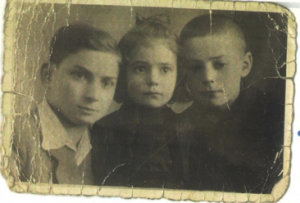In 1930, Ben Fainer (Bendet Fajner) was born in Będzin, Poland. His paternal and maternal families were Orthodox Jewish and had lived in Będzin and the surrounding area for several generations. Ben’s maternal grandfather was a rabbi.
Ben was one of four children. He attended school in the morning for formal studies and Hebrew school in the afternoons. His father was a tailor and his mother sometimes worked as a seamstress. As the oldest child, he helped his mother to fetch water from a town well.

After Germany occupied Będzin, German soldiers forced their way into the Fainer family apartment and shot their dog Rex. When the Nazis compiled a list of all able-bodied men, young Ben, who was large for his age, and his father were taken to a slave labor camp. Ben never saw his mother and his younger siblings again. He spent the remainder of the war in six different labor and concentration camps.
After years of back-breaking labor, near starvation, grueling marches, and horrendous brutality, he was liberated by American soldiers. The first person he spoke to was Sgt. Israel Friedman from Brooklyn, NY. Ben, who knew Polish, Yiddish, and a little German, was surprised to learn that there were American Jewish soldiers.

After liberation, Ben went to his great uncle and two aunts in Dublin (Ireland), who had moved there before the 1939 Nazi invasion of Poland. In Dublin, Ben worked at hisuncle’s garment factory as a tailor. He fell in love with Susie O’Brien, an Irish Catholic. In the early 1950s, interfaith marriages were not accepted; sadly, Ben and Susie married without the blessings of their families.
Newly married, they left Ireland and went to Canada. In 1957 they moved with their three children to St. Louis, Missouri, where they reunited with Ben’s father, who had also survived and now lived there with his second wife and children. Ben and Susie began a new life in St. Louis and had four more children.
Ben did not speak of his experiences for 60 years, often deflecting his family’s curiosity about the number tattooed on his arm. Finally, in 1995, he gave testimony to the Shoah Foundation. A few years later, Ben became a Shoah educator at the St. Louis Holocaust Museum and Learning Center and was speaking frequently for the last 20 years of his life. Thousands of people embraced his story at local churches, schools, and military bases. He always focused on showing students the power of creating and insuring a hate-free tomorrow.
Though always forward-looking, with his childhood, family, and childhood dreams stolen from him, he never recovered from the loss of his mother. Ben never knew what happened to his mom and family. He had no desire to return to Poland. One of his daughters plans to return to Będzin to attend the walk of the living, commemorating the anniversary of the liquidation of Będzin’s ghetto, when she will walk from the HaKoach stadium in Kamionka to the train station, from where her grandmother, aunts, uncles, and other family members were sent to their death in Auschwitz in August 1943.
Ben’s published memoir, Silent for Sixty Years, tells about the heartbreaking years in the camps, his miraculous survival, and his rich family life and successful career in the U.S. It also speaks about the remarkable reunion with one of his American liberators over 50 years later. Three of his children and friends established The Hannah Ida Urman Foundation, named after his mother; the foundation’s mission is to sponsor field trips to Holocaust learning centers and Holocaust educational projects.